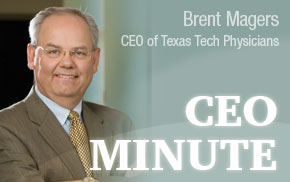 Texas Tech Physicians, through our 1115 Medicaid Waiver program, is looking into variations
of the patient-centered medical homes (PCMH) concept and the necessary components
to support such an undertaking. PCMH is a care delivery model where patient treatment
is coordinated through a primary care physician to ensure the patient receives the
necessary care when and where it is needed. Prevention, diagnosis and treatment are
all to be done in a way the patient can understand what is happening and be a part
of the effort.
Texas Tech Physicians, through our 1115 Medicaid Waiver program, is looking into variations
of the patient-centered medical homes (PCMH) concept and the necessary components
to support such an undertaking. PCMH is a care delivery model where patient treatment
is coordinated through a primary care physician to ensure the patient receives the
necessary care when and where it is needed. Prevention, diagnosis and treatment are
all to be done in a way the patient can understand what is happening and be a part
of the effort.The goal is to have a centralized setting that facilitates partnerships between individual patients and their personal physicians, and when appropriate, the patient’s family. We are in discussions now on pieces of the concept: for example, having care facilitated by registries, patient dashboards and the use of robust information technology, like health information exchanges and portals — all designed to assure patients get the indicated care when and where they need and want it in a culturally and linguistically appropriate manner.
A recent study by Independence Blue Cross of Philadelphia suggests that PCMHs are helpful in controlling the costs of providing care to people with chronic disease. These three-year studies evaluated 125,000 individuals receiving primary care in 160 medical homes between 2008 and 2012 and found a 21 percent lower cost of care for diabetic members in a PCMH, thanks in part to a 44 percent drop in hospital costs. The studies also showed lower emergency room costs after one year, as well as lower costs for chronically ill participants with coronary artery disease, congestive heart failure, chronic obstructive pulmonary disease, asthma and hypertension.
Texas Tech Physicians is excited that we might coordinate in a new way these services that would help our patients lower chronic care costs, but would also improve chronic disease self-management. From the previously cited study, diabetic patients in PCMHs had a 60 percent improvement in getting bad cholesterol under adequate control while the number of patients with poorly controlled diabetes fell 45 percent. None of this is easy, of course. We had the Texas Senior Trails experience, so we are not naïve. Much work lies ahead if the decision is made to proceed, but it is interesting to think, “What if?”
